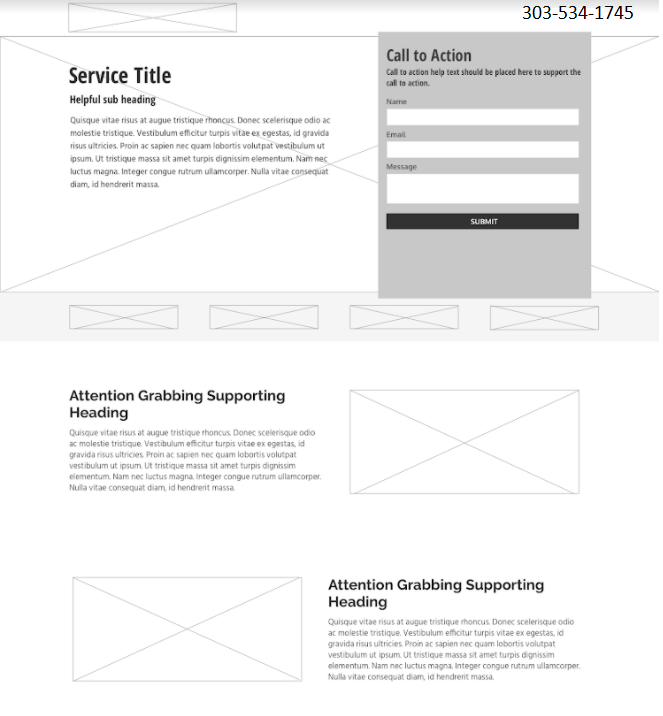
Content Creation
An SEO Centerpiece
Content creation can be thought of as an SEO centerpiece. Good, optimized content is your first and most crucial step towards building effective SEO. Furthermore, it goes without say that you want your content to be meaningful and captivating for your site visitors.
So what does it take to create content that speaks to your audience as effectively as it ranks with search engines? Anyone who writes content will admit that keeping this balance is one of the most difficult pieces of content writing.
Challenge 1: How to Use Clunky Keywords
Due to the way we use search engines, it’s unavoidable that thorough keyword research will leave you with some clunky keywords. It’s normal to search terms such as “pizza Denver” or “Denver pizza pepperoni” when we’re looking for specific products or services. As a result though, fragmented terms like this become high-volume, high-priority keywords found during our research.
So how can we use these keywords in content? How can we possibly write captivating content using words like this?
Clunky Keyword Fail: “Call to order a Denver pizza pepperoni from our pizza Denver restaurant!”
The above attempt at using clunky keywords is, put simply, not correct. While the sentence uses the keywords in their exact format, it doesn’t result in natural sounding language.
The following revision uses the same keywords, only rearranged slightly so that it makes more sense.
Clunky Keyword Fix: ““Call to order a delicious pepperoni pizza from our Denver pizza restaurant!”
As long as the clunky keywords are kept in close proximity, Google and other search engines will be able to read the keyword as an exact match or close variant, increasing the chance that the page will rank well for the keyword in question.
You may also notice that even though the word “Denver” appears in both keywords, I used it only once between the two other keywords within the sentence. Avoiding repetitive geo-modifiers and base words within longer tailed keywords is another thing to pay attention to when writing readable, natural sounding content.
Clunky Geo-modifier Fail: ““Call to order a delicious Denver pepperoni pizza from our Denver pizza restaurant!”
Does natural sounding language really make a difference in SEO?
The answer is yes. Readable content is becoming more and more relevant as a factor in SEO and search rankings. While this may not have been the case 10+ years ago, improved search engine AI as well as the onset of voice search as part of our search ecosystem means that readable, natural sounding content is more important than ever.
Challenge 2: Avoiding Robotic-Sounding Content
We’ve gone over how to use clunky keywords appropriately within content, but we’re still left with having to write pages and pages of content using very specific keywords. Writing is a challenging task to begin with. Is it even possible to write readable content using a structured list of clunky keywords that still appeals to site visitors in a way that helps sell products and services? And can we do it all without sounding robotic and awkward?
The answer, again, is yes! Creating readable, conversion-driven content using keyword sets without sounding robotic is both possible and relatively simple.
Step 1: Write It How You Sell It
If you run a business, you probably talk about regularly with your customers, your friends, and even with yourself. Use this to your advantage! For each area of your site (page, menu, product list, etc) begin jotting down the selling points and pitches you’d use to promote those services or products. In some cases, using a voice-to-text option such as otter.ai may also come in handy if you’re used to promoting your business verbally.

It may also help to use a content wireframe template (see image to the right for an example) at this step. Wireframes can help you to organize your thoughts into a more readable format. A wireframe may also help to inspire thoughts or concepts that help to build captivating content.
Step 2: Find Your Natural Keywords & Integrate the Rest
Once you have your content drafted, the next step is to compare what you have written with your keyword sets for that page or section of your website. What you might find is that you’re probably already using a few of the designated keywords for that page!
After analyzing which keywords you’ve used and which keywords are unrepresented or not yet used, the next thing you can do is to find places where you can implement those keywords naturally into your existing content.
For example, you might compare your keyword set and drafted content and find that the keyword “deep dish pizza” has not been used, yet you’ve used the word “Chicago pan pizza” several times. Swapping out the overused keywords for underrepresented keywords can become a relatively simple task using this method.
At this point, you can also begin looking for creative ways to incorporate keywords. The line below sounds natural and friendly, but is also a blank canvas for adding keywords.
“We also invite you to browse our salad menu.”
This sentence is a great place to add keywords, especially those that may be underrepresented in the rest of your content.
“For a side-dish or a lighter option, we invite you to browse our salad menu. Each salad can be made as vegetarian or gluten-free upon request.”
We hope this article has helped you to better understand the process of creating well-optimized content that is unique and is consistent with your company messaging, but that will also appeal to your clients and customers as well as optimizing your SEO efforts.
Put Our Pros to Work! Ask About Content Creation Services
If you need more help, or if you’ve decided that writing content is a task that just isn’t for you, Denverdata Web is here to help! Our expert digital marketing and SEO team is skilled and experienced in providing exceptional content creation services. Give us a call today at 303-534-1745 or fill out the form above to get started.
